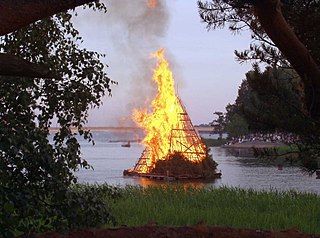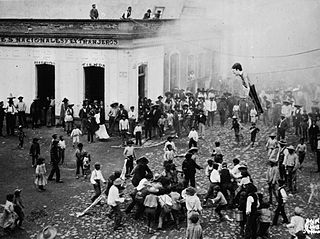
Carnival is a Western Christian festive season that occurs before the liturgical season of Lent. The main events typically occur during February or early March, during the period historically known as Shrovetide. Carnival typically involves public celebrations, including events such as parades, public street parties and other entertainments, combining some elements of a circus. Elaborate costumes and masks allow people to set aside their everyday individuality and experience a heightened sense of social unity. Participants often indulge in excessive consumption of alcohol, meat, and other foods that will be forgone during upcoming Lent. Traditionally, butter, milk, and other animal products were not consumed "excessively", rather, their stock was fully consumed during Shrovetide as to reduce waste. This festival is known for being a time of great indulgence before Lent, with drinking, overeating, and various other activities of indulgence being performed. For example, pancakes, donuts, and other desserts are prepared and eaten for a final time. During Lent, lacticinia and animal products are eaten less, and individuals make a Lenten sacrifice, thus giving up a certain object or activity of desire.

Saint-Jean-Baptiste Day, also known in English as St John the Baptist Day, is a holiday celebrated on June 24 in the Canadian province of Quebec. It was brought to Canada by French settlers celebrating the traditional feast day of the Nativity of Saint John the Baptist. It was declared a public holiday in Quebec in 1925, with publicly financed events organized province-wide by a Comité organisateur de la fête nationale du Québec.

A bonfire is a large and controlled outdoor fire, used either for informal disposal of burnable waste material or as part of a celebration.

Midsummer is a celebration of the season of summer usually held at a date around the summer solstice. It has pagan pre-Christian roots in Europe.

Saint John's Eve, starting at sunset on 23 June, is the eve of the feast day of Saint John the Baptist. This is one of the very few feast days marking a saint's birth, rather than their death. The Gospel of Luke states that John was born six months before Jesus; therefore, the feast of John the Baptist was fixed on 24 June, six months before Christmas. In the Roman calendar, 24 June was the date of the summer solstice, and Saint John's Eve is closely associated with Midsummer festivities in Europe. Traditions are similar to those of May Day and include bonfires, feasting, processions, church services, and gathering wild plants.

An effigy is an often life-size sculptural representation of a specific person, or a prototypical figure. The term is mostly used for the makeshift dummies used for symbolic punishment in political protests and for the figures burned in certain traditions around New Year, Carnival and Easter. In European cultures, effigies were in the past also used for punishment in formal justice, when the perpetrator could not be apprehended, and in popular justice practices of social shaming and exclusion. Additionally, "effigy" is used for certain traditional forms of sculpture, namely tomb effigies, funeral effigies and coin effigies.

Guy Fawkes Night, also known as Guy Fawkes Day, Bonfire Night and Fireworks Night, is an annual commemoration observed on 5 November, primarily in Great Britain, involving bonfires and fireworks displays. Its history begins with the events of 5 November 1605 O.S., when Guy Fawkes, a member of the Gunpowder Plot, was arrested while guarding explosives the plotters had placed beneath the House of Lords. The Catholic plotters had intended to assassinate Protestant king James I and his parliament. Celebrating that the king had survived, people lit bonfires around London. Months later, the Observance of 5th November Act mandated an annual public day of thanksgiving for the plot's failure.

The Sussex Bonfire Societies are responsible for the series of bonfire festivals concentrated on central and eastern Sussex, with further festivals in parts of Surrey and Kent from September to November each year.

The burning of Judas is an Easter-time ritual that originated in European Christian communities where an effigy of Judas Iscariot is burned. Other related mistreatment of Judas effigies include hanging, flogging, and exploding with fireworks. A similar ritual in Jewish tradition would be the hanging and burning an effigy of Haman and his ten sons during Purim, although this is not a widespread contemporary practice.

The Liberty Tree (1646–1775) was a famous elm tree that stood in Boston, Massachusetts near Boston Common in the years before the American Revolution. In 1765, Patriots in Boston staged the first act of defiance against the British government at the tree. The tree became a rallying point for the growing resistance to the rule of Britain over the American colonies, and the ground surrounding it became known as Liberty Hall. The Liberty Tree was felled in August 1775 by Loyalists led by Nathaniel Coffin Jr. or by Job Williams.

The West Country Carnival Circuits are an annual celebration featuring a parade of illuminated carts in the English West Country. The celebration dates back to the Gunpowder Plot of 1605. The purpose is to raise money for local charities.

The Guy Fawkes mask is a stylised depiction of Guy Fawkes created by illustrator David Lloyd for the 1982–1989 graphic novel V for Vendetta. Inspired by the use of a mask representing Fawkes being burned on an effigy having long previously had roots as part of Guy Fawkes Night celebrations, Lloyd designed the mask as a smiling face with red cheeks, a wide moustache upturned at both ends, and a thin vertical pointed beard, worn in the graphic novel's narrative by anarchist protagonist V.

Lewes Bonfire, or Bonfire for short, describes a set of celebrations held in the town of Lewes, Sussex, England, that constitute the United Kingdom's largest and most famous Bonfire Night festivities, with Lewes being called the bonfire capital of the world.

Bonfire Night is a name given to various annual celebrations characterised by bonfires and fireworks. The event celebrates different traditions on different dates, depending on the country. Some of the most popular instances include Guy Fawkes Night in Great Britain, which is also celebrated in some Commonwealth countries; Northern Ireland's Eleventh Night, and 5 November in Newfoundland and Labrador. In various parts of Ireland, Bonfire Nights are held on Saint John's Eve, Bealtaine eve and Halloween. Due to the Thanksgiving Act, up until 1859 celebration of Guy Fawkes Night in the UK was legally mandated, which evolved into the Bonfire Night of today.
Haitian Carnival is a celebration held over several weeks each year leading up to Mardi Gras. Haitian Defile Kanaval is the Haitian Creole name of the main annual Mardi Gras carnival held in Port-au-Prince, Haiti.

Póvoa de Varzim Holiday, Saint Peter Festivals or Saint Peter Night is celebrated annually on June 29, Saint Peter's Day in Póvoa de Varzim, Portugal. It is a late midsummer festival and the last of the three Portuguese popular saints — Santos Populares. It is celebrated with the lighting of bonfires, dances, competitions between quarters and diverse parties. Saint Peter festival includes the "rusgas", in which inhabitants of one quarter (bairro) visit in a parade other quarters in the evening of June 28. Women are dressed as tricana poveira. Each neighborhood has its own festival, neighborhood colors and altar to Saint Peter.

In the spring and summer of 1715 a series of riots occurred in England in which High Church mobs attacked over forty Dissenting meeting-houses. The rioters also protested against the first Hanoverian king of Britain, George I and his new Whig government. The riots occurred on symbolic days: 28 May was George I's birthday, 29 May was the anniversary of Charles II's Restoration and 10 June was the birthday of the Jacobite Pretender, James Francis Edward Stuart.
Ebenezer Mackintosh was a shoemaker who lived in New England in the 18th and 19th centuries. He is known for his role as a leader in Boston riots protesting the Stamp Act.
The Knowles Riot, also known as the Impressment Riot of 1747, was a three-day riot in Boston that began on 17 November 1747, in response to the impressment of 46 Bostonians by Admiral Charles Knowles into the navy. Hundreds of mostly working-class rioters rampaged through Boston, paralyzed the provincial government, and captured several naval officers and the sheriff's deputy. After Knowles threatened to bombard the town, the British governor of Boston, William Shirley, persuaded him to release the Bostonians in exchange for the hostages.

The Loyal Nine were nine American patriots from Boston who met in secret to plan protests against the Stamp Act of 1765. Mostly middle-class businessmen, the Loyal Nine enlisted Ebenezer Mackintosh to rally large crowds of commoners to their cause and provided the protesters with food, drink, and supplies. A precursor to the Sons of Liberty, the group is credited with establishing the Liberty Tree as a central gathering place for Boston patriots.

















